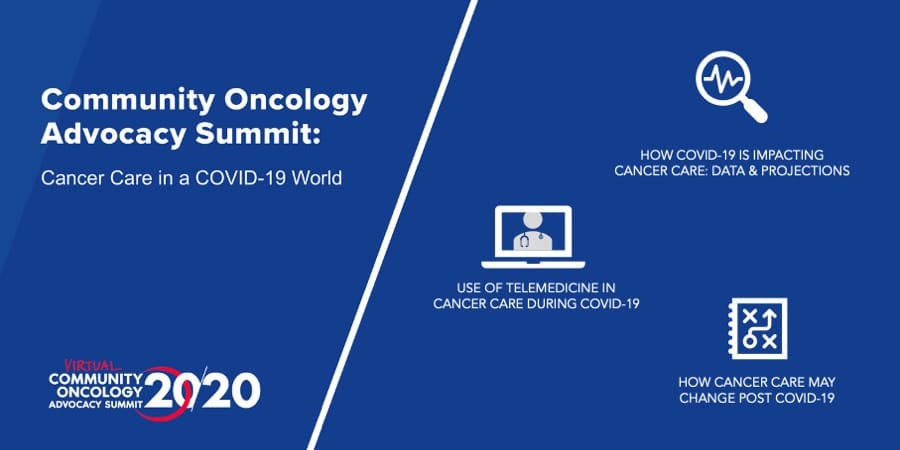The Community Oncology Alliance recently hosted a virtual Advocacy Summit focused on Cancer Care in a COVID-19 World. COA assembled leading community cancer care providers from across the country to share their thoughts on topics including the current impact of the virus, what the most appropriate use cases are for telehealth, and future considerations for community cancer care.
How COVID-19 is impacting cancer care: data & projections
To provide insight into the impact the virus has had, Lucio Gordan, MD of Florida Cancer Specialists & Research Institute shared the responses to a survey his team recently deployed to practice administrators and managers from 160 specialty practices (30% oncology).
- More than 50% of practices experienced greater than 50% reduction in total practice volume, driven by a reduction of new patient encounters.
- Approximately 50% of clinical research practices experienced a minimum of 30% reduction in clinical trial enrollment
- A majority of practices have furloughed or terminated less than 10% of employees
- More than 50% of practices, regardless of specialty, were uncertain if the federal stimulus packages will last the next 6 ot 9 months
Use of telemedicine in cancer care during COVID-19
Even in the face of a lot of uncertainty, community-based cancer programs continue to adapt and adjust to safely care for their patients. Out of necessity, a major part of that response included a huge spike in the use of telehealth – and most think it’s here to stay. How should telehealth ideally be used in cancer care, though? Debra Patt, MD, MPH, MBA of Texas Oncology shared her perspective on the topic.
Cancer care providers will likely need to advocate for telemedicine when current policies come to an end and Dr. Patt sees several appropriate and meaningful and positive outcomes of the use of telehealth:
- Ensures the office is safe for those who have to come in
- Allows infectious patients to receive care without endangering others
- Helps keeps patients out of hospitals
- Enables evaluation of new patients without added volume to the clinic setting
- Expands services limited by geography
- Accommodates family for important end of life discussions
- Useful for delivering important information to patients while ensuring their safety: genetics evaluation, nutrition and supportive care, chemotherapy teaching
How cancer care may change post COVID-19
So what does the future look like for cancer care? While Barry Russo, MBA of The Center for Cancer & Blood Disorders and Anthony Scalzo, MD, of Hematology Oncology Associates of Central New York did not profess to know the future – describing it as a moving target at the moment – they did share 10 key considerations:
- Testing is essential for patients who are symptomatic, staff who are symptomatic and staff who has been exposed without PPE – that will be standard moving forward
- Telemedicine’s use needs to be more formalized so that it’s clear which patients and what visit types it’s appropriate for.
- Patient electronic communications systems need to be more robust – patients need to know who to contact when they need help, have access to a portal to stay connected, and as patients become more comfortable with technology add even more sophisticated tools to stay connected.
COVID-19 screening of patients and visitors in the clinic will need to be automated for efficiency – whether its thermal technology, facial recognition, or digital surveys – technology will play a role. - Surgical services will be impacted as providers work to keep patients out of the hospital and oral and hormonal therapy support may be needed as surgical services are interrupted.
- Isolation capabilities for positive and potentially positive patients will need to be enhanced so that all patients can be safely treated and staff is also kept safe.
- Management of high risk populations will be an ongoing consideration – from nursing home residents to federal prisoners – vulnerable populations will be at risk – rapid COVID testing would be very helpful.
- Integration of family members and caregivers in the care continuum has been disrupted so extra attention needs to be given to inclusion and communication for the patient and their caregivers.
- Disinfection isn’t going away – waiting rooms will be impacted and clinics are adding enhanced methods to keep everything as clean and safe as possible including specialized HVAC systems and UV light systems.
- Delivery of patient education will need to take into account the new virtual world – with technology based communication, the information can be delivered in a timely manner and be readily available for future reference.
To close this talk, Bo Gamble, COA’s Director of Strategic Practice Initiatives, asked the presenters if they had an “aha” moment that made them wonder “why did we wait for COVID-19 to make this change?” Both speakers agreed rigorous disinfection and temperature checks should have been standard procedure all along.
COA’s Advocacy Summit presented both a clear picture of what’s happening today as well as some thoughts on the road forward. COVID-19 has had a significant impact on cancer care, but community cancer care providers are responding, learning, and moving forward to continue to serve the patients in their communities with high quality care, compassion, and innovation.
